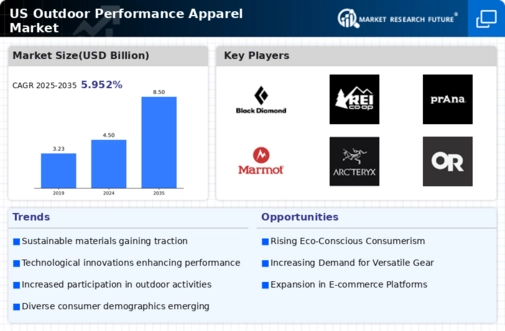Health and Wellness Trends
The outdoor performance-apparel market is significantly influenced by the rising health and wellness movement in the United States. As individuals become more health-conscious, there is a corresponding increase in outdoor activities that promote physical fitness. Reports suggest that nearly 70% of Americans consider outdoor exercise as a vital component of their health regimen. This growing awareness of the benefits of outdoor activities is driving demand for performance apparel that offers comfort, durability, and functionality. The outdoor performance-apparel market is likely to see continued growth as consumers invest in gear that supports their active lifestyles, further intertwining health and outdoor engagement.
Increased Outdoor Participation
The outdoor performance-apparel market is experiencing a notable surge in consumer engagement, driven by a growing interest in outdoor activities such as hiking, camping, and trail running. Recent data indicates that approximately 50% of Americans participate in outdoor activities at least once a year, reflecting a cultural shift towards embracing nature. This trend is likely to bolster demand for high-quality performance apparel designed to withstand various environmental conditions. As consumers seek gear that enhances their outdoor experiences, brands are responding with innovative designs and materials. The outdoor performance-apparel market is thus positioned to benefit from this increased participation, as more individuals prioritize outdoor adventures and the associated need for specialized clothing.
E-commerce Growth and Accessibility
The outdoor performance-apparel market is benefiting from the rapid expansion of e-commerce platforms, which provide consumers with greater access to a diverse range of products. Online sales of outdoor apparel have surged, with estimates indicating that e-commerce accounts for over 30% of total sales in the apparel sector. This shift towards online shopping allows consumers to compare products, read reviews, and access a wider selection of brands. As a result, the outdoor performance-apparel market is likely to experience increased sales as consumers embrace the convenience of online purchasing. Retailers are also adapting their strategies to enhance the online shopping experience, further driving market growth.
Technological Advancements in Fabric
The outdoor performance-apparel market is witnessing a transformation due to advancements in fabric technology. Innovations such as moisture-wicking materials, breathable fabrics, and temperature-regulating technologies are becoming increasingly prevalent. These developments not only enhance the performance of outdoor apparel but also cater to the evolving preferences of consumers who seek multifunctional clothing. For instance, the integration of smart textiles that monitor body temperature and exertion levels is gaining traction. As these technologies become more accessible, the outdoor performance-apparel market is poised for growth, as consumers are likely to gravitate towards apparel that offers enhanced performance and comfort during their outdoor pursuits.
Environmental Awareness and Ethical Consumption
The outdoor performance-apparel market is increasingly shaped by consumer awareness regarding environmental issues and ethical consumption. As more individuals prioritize sustainability, brands are responding by adopting eco-friendly practices in their production processes. This includes the use of recycled materials and sustainable sourcing methods. Recent surveys indicate that approximately 60% of consumers are willing to pay a premium for sustainable apparel. Consequently, the outdoor performance-apparel market is likely to see a shift towards brands that align with these values, as consumers seek products that not only perform well but also reflect their commitment to environmental stewardship.

























Leave a Comment